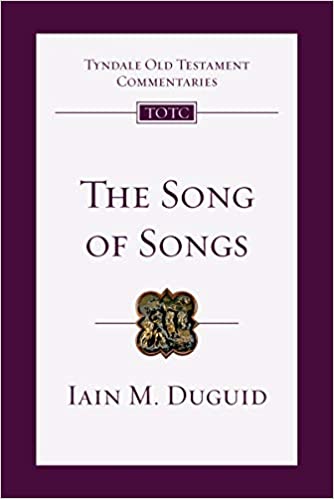A Book Review from Books At a Glance
by G. T. Tran
Summary of Content
One notable treatment of the Song of Songs in recent years is Iain Duguid’s contribution to the Tyndale Old Testament Commentary series. The format of this series is fourfold: 1) Introduction, 2) Analysis (i.e., structure), 3) Translation (by the author), and 4) Commentary.
In the Introduction, Duguid deals with various background issues, some of which are authorship, date, interpretation, and themes. Duguid does not find the phrase “which is Solomon’s” (אשׁר לשׁלמה) in Song 1:1 to indicate Solomonic authorship (19-20). He also prefers a post-exilic date for the book (23). After noting a variety of interpretive traditions, Duguid concludes, “[T]he Song of Songs is best understood as a wisdom piece about two idealized people, a man and a woman, whose exclusive and committed love is deep but, like all lovers in this fallen world, far from perfect” (36). Importantly, this couple is not Solomon and the Shulammite maiden but rather the maiden and her shepherd lover (36-37). Duguid is hesitant about the typological approach (27-28) and suggests that the book’s connections to Christ be made through a “parabolic” approach (see 37-38). He treats the Song as a unified work and analyzes it in seven parts (53-56), as shown below.
- Title 1:1
- Prologue 1:2—2:7
- Before the Wedding: Joined & Separated 2:8—3:5
- The Wedding 3:6—5:1
- After the Wedding: Separated & Rejoined 5:2—6:3
- Contemplation & Renewed Consummation 6:4—8:4
- Epilogue 8:5-14
Meanwhile, he cautions: “That is not to say that the poem tells a straightforward sequential narrative” (53). For each of the seven parts, Duguid provides its context, literary structure, comments, applications, as well as connections to Christ.
Evaluation of Content
At least two commendable aspects of the commentary may be observed. First, Duguid nicely surveys major interpretive issues of the Song in just 15 pages (24-38). His presentation is concise, to-the-point, and alerts readers to many challenges in interpreting the book.
Second, Duguid offers a simple yet convincing argument for the unity of the book. He writes, “The singular form, ‘song’ (šîr), suggests that this book comprises a single song” (72). This singular construction stands in contrast to the plural constructions in Prov 1:1 (the proverbs of Solomon) and Ps 72:20 (the prayers of David) which indicate “a diverse collection of disparate materials” (72). For that reason, Duguid concludes, “We should therefore expect to find a unified message in what follows such a title, in spite of its diversity” (72). Unfortunately, many scholars do not take this observation seriously, and as a result, they approach the Song as a mere collection of love poems. Tremper Longman III, for example, dissects the book into twenty-three poems (see Song of Songs [Eerdmans, 2001])!
Amidst these strengths, I find Duguid’s interpretation of אשׁר לשׁלמה (and hence his rejection of Solomonic authorship) in Song 1:1 unpersuasive. While he concedes that the ל could indicate authorship (i.e., “by Solomon”), he posits that the accompanying pronoun אשׁר (“which”) points to understanding the ל as possessive (i.e., “of Solomon”) (73-74). Nevertheless, I wonder if the grammatical construction in Song 1:1 is simply stylistic. Duguid draws a hard distinction in meaning between the ל of authorship and the possessive ל but saying that the Song belongs to Solomon does not rule out the possibility that he wrote it. To put it another way, if Solomon authored the Song, then the Song was his.
Duguid’s treatment of the Song is very helpful. He has helped us see the unified message of the book, and for that, we should be grateful. I heartily recommend this commentary!
G. T. Tran
